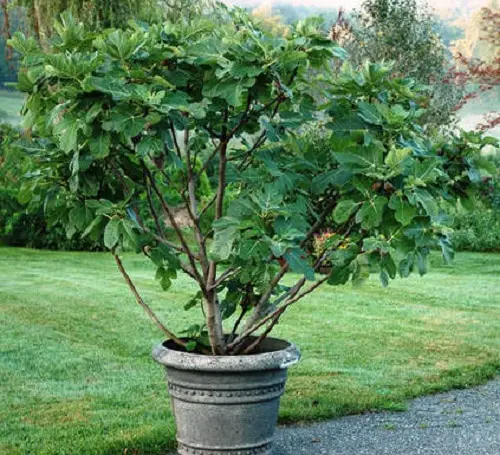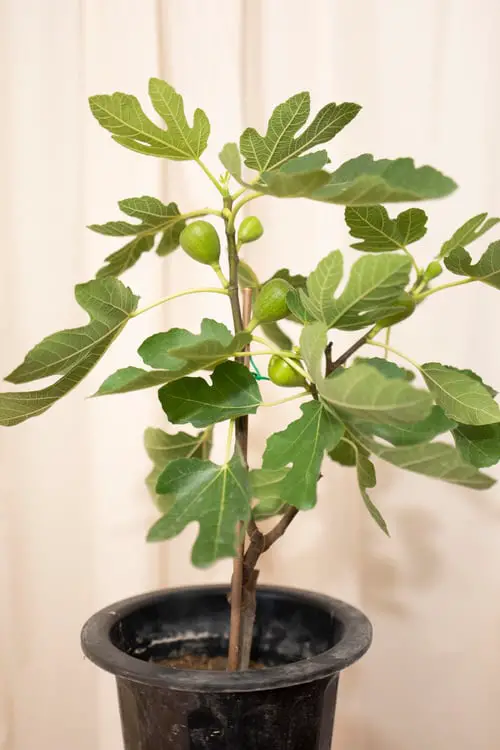Do you want to have a fresh supply of figs in a compact space? Here are all the details and more on How to Grow a Fig Tree in a Pot!
Fig offers you the best of both worlds – it looks great with the glossy foliage when the plant is not fruiting and when it does, you can enjoy the tasty harvest with your heart’s content! If you are short on space, then here’s everything on How to Grow a Fig Tree in a Pot.
Check out our article on growing apple trees in pots here
Best Fig Varieties for Pots

While growing figs in pots, you need first to choose an appropriate variety that would be suitable for containers. Here are a few cultivars to choose from that are suitable for growing in pots:
- Blanche: It is a cold-hardy fig that is quite popular among the youth gardeners. The plant is a slow grower with a denser canopy and produces large, medium-scented fruits.
- Brown Turkey: This one is a small cultivar that offers plenty of medium-sized fruits and is most suited for containers.
- Celeste: It has light brown-purple-colored skinned fruits with bright pink flesh that are mostly consumed as dried figs.
- Verte: This compact fig variety produces giant figs that grow ripe late in the season and are much suitable to grow in cold temperatures.
- Chicago: This is another fantastic weather cultivar suitable for growing in containers and it is one of the most cold-tolerant fig trees.
Propagating Fig Tree
The best way to propagate a fig tree in a pot is by cuttings. Take a 6-8 inches long cutting from a healthy tree and pot in a container filled with a quality potting mix. If you don’t want to wait, you also have an option to get a well-grown plant from a nursery or a garden center.
Choosing a Container
Pick a 12-16 inches pot made of any material such as clay, ceramic, or even wood. Just ensure the container has enough drainage holes to allow the excess water to drain out. The pot size also depends on the variety you are growing. You can also go for a 10-12 inch pot and then re-pot the plant when it outgrows the old container.
Tip: Consider planting the fig tree in a container with wheels for easy mobility. Consider using a wheeled plant stand that you can buy from any hardware store, garden center, or even a nursery.
Requirements for Growing Fig Tree in a Pot

Location
To make sure your fig is healthy, strike the right balance of shade and light. Avoid exposing the plant to the harsh sunlight, while making sure it gets the right dab of the morning sun. For ample fruiting, the tree must get 4-6 hours of light every day.
Soil
The tree is not fussy about the growing medium and can do well in the regular garden soil. However, it does best in fast-draining and well-aerated soil. A sandy-clay loam growing medium with a pH range of 6.0 to 8.0 is going to do wonders for the plant.
Watering
The tree likes the soil on the moist side. During fruiting, make sure that the soil is never getting dry. Water when the topsoil gets a bit on the dry side. Once the fruiting begins, ensure enough water to promote plump and juicy fruits.
Temperature
The ideal temperature to grow fig trees is between 60-75 F (15-24 C). Do make sure that the plant is not exposed to temperatures below 50 F (10 C) for a longer duration of time. It can easily survive temperatures upto 100 F (38 C).
Pruning
Unlike most of the other fruit-bearing trees, usually, fig trees do not require regular pruning. Prune the plant to maintain its shape. Also, snip away the damaged leaves and stems from time to time.
Fig Tree in a Pot Care

Fertilizer
While growing fig trees in pots, go for high nitrogen fertilizer, every 4-5 weeks, in spring and early summer. You can also use compost and mulch as it will help the plant retain moisture better. Also, refrain from feeding the plant in winters. You can also use banana peels and liquid fertilizer tea.
Autumn Care
If you live in a cold climate and notice the leaves falling, then it is an indication of autumn. It would help if you moved the tree immediately to a garage, shed, or an unheated basement where the tree can go into its dormant state.
During the dormant phase, check on the tree occasionally for its soil moisture. First, let the soil turn dry to the touch, 2-3 inches below the surface before you start to water it. Avoid overwatering your dormant fig tree to prevent rotting and other issues.
Pests and Diseases
Be careful about spider mites, gnats, whiteflies. The best way to get rid of them is using a strong jet of water and a neem oil solution. Avoid overhead watering to eliminate the chances of brown spots on the leaves. Always water the plant at the base.
Overwintering Fig Tree in Pot
Growing and caring for fig trees in colder climates could mean a little bit of hard work. It would be best if you move them indoors after autumn’s first frost. Choose a spot like inside the garage, cellar, or shed. A bedroom with a south-facing window will be an apt location too. Just make sure that the plant is not exposed to cold drafts of air.
After the danger of frost is gone, you can move the container outdoors for the remaining growing season.
Harvesting Figs
If you live in a warm climate, then the tree may fruit twice – once in late spring or early summer to fall. However, fruiting also depends a lot on the variety you have grown. Ripe fruits are slightly soft to touch with split skin. You can use a shear to snip them cleanly from the tree.
Some Interesting Facts About Fig Tree
- Fig trees do not produce any flowers. There are tiny blossoms that develop inside the fruits of the fig tree.
- The fig tree represents fertility. Many also believe that the fruit mentioned in Eden Garden was a fig.
- Figs are highly rich in calcium and dietary fiber fruits. They are also known as Food of the Gods.
- Earlier, it was the Spaniards who brought the fig to California in the early 1600s. Now, California produces nearly 98 percent of all figs grown commercially in the U.S.A.
- The most commonly grown variety of figs is the Mission fig.
- Figs could be an excellent addition to baked goods as they hold moisture well.
- Fig puree can be used as a substitute in baking recipes for oil and butter.
- It is a known fact that the dried figs taste good but, fresh figs taste even better!



I love fig trees! I have one in my front yard and it’s so beautiful. I’m going to have to try this method to grow one in a pot.
I have a Celeste fig tree. I’ve had it for two years. It’s has tons of leaves but I’ve never had a fig. it is in a container outside. What am I doing wrong?
Probably nothing. Took my tree 4 years to fruit. Planted in the ground in Kansas City.